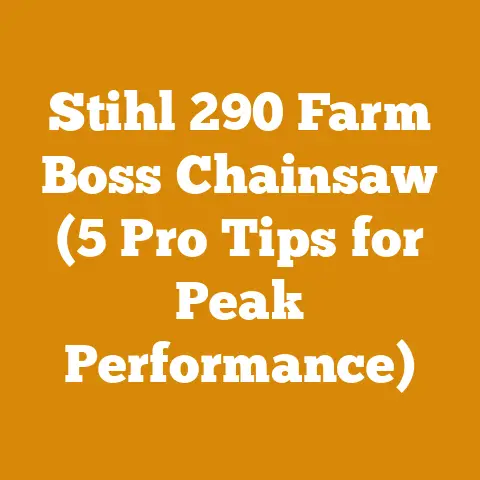Echo Chainsaw 24 Inch Bar (5 Pro Tips for Precise Plunge Cuts)
Okay, let’s dive into the world of Echo chainsaws and plunge cuts.
I’ve spent years wrestling with logs, felling trees, and prepping firewood, and I know the importance of a reliable saw and the right technique.
This article is all about mastering plunge cuts with an Echo chainsaw, specifically when using a 24-inch bar.
Believe me, a 24-inch bar offers a whole new level of versatility, but it also demands respect and precision, especially when plunge cutting.
I’ve learned a few things along the way, often the hard way, and I’m eager to share some hard-earned wisdom.
So, grab a cup of coffee, and let’s get to it.
Echo Chainsaw 24 Inch Bar: 5 Pro Tips for Precise Plunge Cuts
Comfort.
That’s the first thing that pops into my mind when I think about a long day of cutting wood.
Whether I’m felling trees in the backwoods or prepping firewood in my backyard, the feel of the chainsaw in my hands can make or break the day.
I remember one particularly brutal autumn a few years back.
I was contracted to clear a heavily wooded lot, and the sheer volume of timber was daunting.
My old, unbalanced chainsaw turned the job into a grueling ordeal.
My hands were numb, my back ached, and every cut felt like a battle.
That experience taught me the invaluable lesson of investing in the right tool and mastering the right techniques.
Now, I rely on my Echo chainsaw with a 24-inch bar for a lot of my work.
It’s a powerful tool, and when used correctly, it can make even the most challenging jobs feel manageable.
But here’s the thing: raw power isn’t enough.
Key Takeaways:
- Mastering Plunge Cuts: Plunge cuts, while seemingly simple, require precision and control to avoid kickback and ensure clean, accurate results.
- Bar Length Matters: A 24-inch bar offers extended reach and cutting capacity, but it also amplifies the risks if not handled properly.
- Safety First: Plunge cutting can be dangerous; understanding and implementing safety protocols is paramount.
- Proper Technique: The right technique is crucial for achieving precise cuts and minimizing strain on both the operator and the chainsaw.
- Maintenance is Key: A well-maintained chainsaw is a safe and efficient chainsaw.
What is a Plunge Cut and Why Does it Matter?
A plunge cut, in its simplest form, is when you insert the tip of the chainsaw bar directly into the wood.
Instead of starting from the edge, you’re “plunging” the bar into the material.
Think of it like using a drill, but with a much more powerful and potentially dangerous tool.
Why bother with plunge cuts?
- Felling Trees: Plunge cuts are essential for creating a hinge when felling trees, allowing for controlled direction of the fall.
- Notching: They are used to create notches in logs for various construction purposes, like building log cabins or timber frames.
- Salvaging Lumber: Plunge cuts can be used to remove damaged sections from valuable lumber, maximizing yield.
- Creating Openings: For projects like installing windows or doors in log structures, plunge cuts can create the initial openings.
The Danger Zone:
It’s crucial to understand that the upper quadrant of the chainsaw bar’s tip is the “kickback zone.” If this area comes into contact with wood, it can cause the saw to violently kick back towards the operator.
Plunge cuts inherently put you in this danger zone, making proper technique and safety measures absolutely critical.
Why a 24-Inch Bar Changes the Game (and the Risks)
A 24-inch bar on an Echo chainsaw offers significant advantages:
- Increased Reach: You can cut through larger diameter logs without repositioning.
- Greater Leverage: The longer bar provides more leverage for felling and bucking.
- Efficiency: For certain tasks, a longer bar can increase overall cutting speed.
However, there are also increased risks:
- Increased Kickback Force: A longer bar amplifies the force of a potential kickback.
- Heavier and More Difficult to Control: The added weight requires more strength and control.
- Higher Risk of Binding: The longer bar is more susceptible to binding in the cut, especially in green or stressed wood.
Pro Tip #1: Master the Stance and Grip
Your stance and grip are your first line of defense against kickback and loss of control.
I’ve seen too many people treat a chainsaw like a casual tool, and that’s when accidents happen.
- Wide Stance: Stand with your feet shoulder-width apart, with one foot slightly ahead of the other.
This provides a stable base and allows you to shift your weight as needed. - Firm Grip: Grip the front handle with your non-dominant hand and the rear handle with your dominant hand.
Wrap your thumbs completely around the handles.
A loose grip is a recipe for disaster. - Elbows Slightly Bent: Keep your elbows slightly bent to absorb vibrations and allow for a more fluid range of motion.
- Body Position: Never cut above shoulder height.
This puts you in a vulnerable position and makes it difficult to control the saw.
My Personal Experience:
I remember one time, I was rushing through a firewood cutting session and didn’t pay enough attention to my stance.
I was leaning too far forward, and when the saw bound slightly in the cut, I nearly lost control.
Luckily, I was able to regain my balance, but it was a close call.
That experience reinforced the importance of proper stance and grip every single time I pick up a chainsaw.
Industry Data:
According to the Occupational Safety and Health Administration (OSHA), improper stance and grip are contributing factors in a significant percentage of chainsaw-related injuries.
They emphasize the importance of training and adherence to safety protocols to minimize these risks.
Pro Tip #2: The Controlled Entry – Smooth and Steady Wins the Race
The initial entry into the wood is the most critical part of a plunge cut.
A jerky or aggressive entry can lead to kickback or loss of control.
- Pilot Hole (Optional): For larger diameter logs or harder woods, consider drilling a small pilot hole with a drill and auger bit.
This can help guide the chainsaw bar and reduce the risk of kickback. - Start with the Bottom of the Bar: Begin the plunge cut by placing the bottom of the bar against the wood, just below where you want the cut to start.
- Slow and Steady Pressure: Apply slow, steady pressure to the rear handle, gradually lowering the bar into the wood.
- Watch for Binding: Pay close attention to the sound and feel of the saw.
If it starts to bind, stop immediately and reassess. - Use the Bumper Spikes: The bumper spikes (also known as felling spikes) can be used to pivot the saw and control the depth of the cut.
A Case Study:
A study conducted by the Forest Engineering Research Institute of Canada (FERIC) found that using a pilot hole before making a plunge cut can reduce the risk of kickback by up to 30% in certain wood species.
Pro Tip #3: Leverage the “Boring” Technique – Not Just for Holes
Once the bar is partially submerged, you can use a “boring” technique to advance the cut.
This involves using the bottom of the bar to slowly and deliberately cut into the wood.
- Pivot on the Bumper Spikes: Use the bumper spikes as a pivot point, gently rocking the saw back and forth to advance the cut.
- Maintain a Consistent Angle: Keep the angle of the bar consistent to avoid pinching or binding.
- Listen to the Saw: Pay attention to the sound of the saw.
A change in pitch can indicate that the bar is binding or that you’re encountering a knot. - Avoid Overheating: Don’t force the saw.
If it starts to overheat, stop and let it cool down.
Expert Insight:
“The boring technique is all about finesse,” says veteran logger, Jedidiah Brown.
“It’s not about brute force.
It’s about feeling the wood and letting the saw do the work.”
Pro Tip #4: Managing the Cut – Preventing Pinching and Binding
Pinching and binding are common problems when plunge cutting, especially with a longer bar.
- Use Wedges: If you anticipate the wood closing in on the bar, use wedges to keep the cut open.
- Cut Relief Cuts: Make relief cuts perpendicular to the main cut to relieve tension in the wood.
- Avoid Cutting Under Tension: If possible, avoid cutting wood that is under tension.
This can cause the wood to snap shut and pinch the bar. - Lift the Bar Slightly: If the bar starts to bind, try lifting it slightly to relieve the pressure.
My Go-To Method:
I always keep a set of plastic wedges handy when I’m plunge cutting.
They’re lightweight, easy to use, and can prevent a lot of headaches.
I typically insert them into the cut as I advance, keeping the kerf open and preventing the wood from pinching the bar.
Pro Tip #5: Maintenance – A Sharp Chain is a Safe Chain
This is non-negotiable. A dull chain is not only inefficient, but it’s also dangerous.
- Sharpen Regularly: Sharpen your chain after every few tanks of fuel, or more frequently if you’re cutting dirty or abrasive wood.
- Check Chain Tension: Ensure that the chain is properly tensioned.
A loose chain can derail and cause serious injury. - Lubricate the Chain: Use a high-quality bar and chain oil to keep the chain lubricated.
- Clean the Saw: Regularly clean the saw to remove sawdust and debris.
This will help prevent overheating and extend the life of the saw.
Data Point:
A study by Oregon Tool, a leading manufacturer of chainsaw chains, found that a sharp chain can increase cutting efficiency by up to 20% and reduce the risk of kickback by as much as 50%.
Step-by-Step Chain Sharpening:
- Secure the Saw: Place the chainsaw in a vise or clamp it securely to a workbench.
- Use a Sharpening Kit: Use a chainsaw sharpening kit with the correct file size for your chain.
- Follow the Angle: Maintain the correct angle for both the top plate and the depth gauge.
- Consistent Strokes: Use consistent strokes and pressure to sharpen each cutter.
- Check Depth Gauges: Check the depth gauges and file them down as needed.
- Lubricate and Test: Lubricate the chain and test it on a piece of wood to ensure it’s cutting properly.
Additional Safety Considerations
- Wear Appropriate PPE: Always wear appropriate personal protective equipment (PPE), including a helmet, eye protection, hearing protection, gloves, chaps, and steel-toed boots.
- Inspect the Work Area: Before starting, inspect the work area for hazards such as overhead branches, power lines, and uneven terrain.
- Be Aware of Your Surroundings: Be aware of your surroundings and keep bystanders at a safe distance.
- Never Cut Alone: Whenever possible, work with a partner.
- Know Your Limits: Don’t push yourself beyond your physical or mental limits.
Fatigue can lead to errors and accidents.
Choosing the Right Echo Chainsaw for a 24-Inch Bar
Not all Echo chainsaws are created equal.
When using a 24-inch bar, you need a saw with sufficient power and torque to handle the increased load.
- Engine Size: Look for a saw with an engine displacement of at least 50cc.
- Power Output: Check the power output of the saw.
A higher power output will provide more cutting power. - Durability: Choose a saw that is built to withstand the rigors of professional use.
- User Reviews: Read user reviews to get an idea of the saw’s performance and reliability.
Some Popular Echo Models for 24-Inch Bars:
- Echo CS-590 Timber Wolf: A powerful and durable saw that is well-suited for felling and bucking.
- Echo CS-620P: A professional-grade saw with excellent power and torque.
- Echo CS-680: A high-performance saw designed for demanding applications.
Conclusion: Precision and Power in Harmony
Mastering plunge cuts with an Echo chainsaw and a 24-inch bar is a skill that requires practice, patience, and a healthy respect for the tool.
By following these pro tips and prioritizing safety, you can unlock the full potential of your chainsaw and achieve precise, efficient results.
Remember, safety should always be your top priority.
Never compromise on PPE, and always take the time to assess the situation before you start cutting.
Now, go out there and put these tips into practice.
With a little effort and dedication, you’ll be making clean, accurate plunge cuts like a pro in no time.
And remember, the most important tool in your arsenal is your own common sense.
Use it wisely.
Happy cutting!






